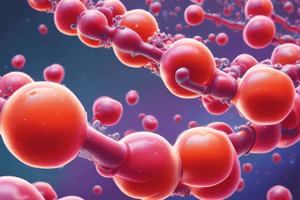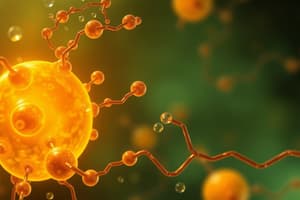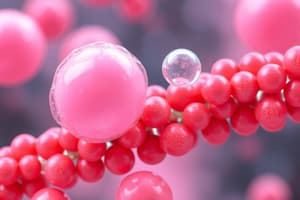Podcast
Questions and Answers
ما هي الخاصية التي تميز الفسفوليبيدات؟
ما هي الخاصية التي تميز الفسفوليبيدات؟
- محبة للماء فقط
- مزدوجة المحبة للماء والدهون (correct)
- كارهة للماء فقط
- غير قطبية
مما يتكون رأس الفسفوليبيد؟
مما يتكون رأس الفسفوليبيد؟
- مجموعة محبة للماء (correct)
- مجموعة بروتينية
- مجموعة دهنية
- مجموعة كارهة للماء
ما هي طبيعة ذيل الفسفوليبيد؟
ما هي طبيعة ذيل الفسفوليبيد؟
- قطبية
- محبة للماء
- مذيبة للدهون
- كارهة للماء (correct)
ماذا يعني مصطلح 'مزدوجة المحبة' المستخدم لوصف الفسفوليبيدات؟
ماذا يعني مصطلح 'مزدوجة المحبة' المستخدم لوصف الفسفوليبيدات؟
أين توجد الفسفوليبيدات بشكل رئيسي في الطبيعة؟
أين توجد الفسفوليبيدات بشكل رئيسي في الطبيعة؟
ما هي النتيجة الرئيسية لاختلال عملية التمثيل الغذائي للكوليسترول والبروتينات الدهنية؟
ما هي النتيجة الرئيسية لاختلال عملية التمثيل الغذائي للكوليسترول والبروتينات الدهنية؟
ماذا يحدث لأيض الأحماض الدهنية والبروتينات الدهنية في مرض السكري؟
ماذا يحدث لأيض الأحماض الدهنية والبروتينات الدهنية في مرض السكري؟
ما هي الحالة المرضية التي قد تنتج عن اختلال أيض الأحماض الدهنية في مرض السكري؟
ما هي الحالة المرضية التي قد تنتج عن اختلال أيض الأحماض الدهنية في مرض السكري؟
ما العلاقة بين اختلال أيض الكوليسترول وتصلب الشرايين؟
ما العلاقة بين اختلال أيض الكوليسترول وتصلب الشرايين؟
أي من الآتي يعتبر نتيجة مباشرة لاختلال الأيض في مرض السكري؟
أي من الآتي يعتبر نتيجة مباشرة لاختلال الأيض في مرض السكري؟
أي من الدهون التالية مشتقة من VLDL؟
أي من الدهون التالية مشتقة من VLDL؟
ما هي العملية التي يتم من خلالها اشتقاق الدهون المشتقة من الدهون الأخرى؟
ما هي العملية التي يتم من خلالها اشتقاق الدهون المشتقة من الدهون الأخرى؟
بالمقارنة مع VLDL، كيف تكون كثافة LDL؟
بالمقارنة مع VLDL، كيف تكون كثافة LDL؟
ما هي نسبة الدهون الثلاثية الموجودة في LDL مقارنة بـ VLDL؟
ما هي نسبة الدهون الثلاثية الموجودة في LDL مقارنة بـ VLDL؟
أي من التالي يمثل وصفًا صحيحًا للدهون المشتقة؟
أي من التالي يمثل وصفًا صحيحًا للدهون المشتقة؟
ما هو الإنزيم المنظم الرئيسي في عملية تخليق الكوليسترول؟
ما هو الإنزيم المنظم الرئيسي في عملية تخليق الكوليسترول؟
ما هو الجزيء الذي يوفر المكافئات المختزلة لإنزيم HMG CoA ريدكتيز؟
ما هو الجزيء الذي يوفر المكافئات المختزلة لإنزيم HMG CoA ريدكتيز؟
يتم التحكم في عملية تخليق الكوليسترول بشكل رئيسي عن طريق أي آلية؟
يتم التحكم في عملية تخليق الكوليسترول بشكل رئيسي عن طريق أي آلية؟
ما هو الناتج المباشر لتفاعل إنزيم HMG CoA ريدكتيز؟
ما هو الناتج المباشر لتفاعل إنزيم HMG CoA ريدكتيز؟
أين يوجد إنزيم HMG CoA ريدكتيز داخل الخلية؟
أين يوجد إنزيم HMG CoA ريدكتيز داخل الخلية؟
ماذا يحدث لتخليق إنزيم HMG CoA reductase عندما يزداد تركيز الكوليسترول في الخلية؟
ماذا يحدث لتخليق إنزيم HMG CoA reductase عندما يزداد تركيز الكوليسترول في الخلية؟
أي من التالي يسبب تقليل في تخليق إنزيم HMG CoA reductase؟
أي من التالي يسبب تقليل في تخليق إنزيم HMG CoA reductase؟
ما هي الآلية التي تعكس تأثير زيادة تركيز الكوليسترول على إنزيم HMG CoA reductase؟
ما هي الآلية التي تعكس تأثير زيادة تركيز الكوليسترول على إنزيم HMG CoA reductase؟
في حال انخفاض تركيز الكوليسترول الخلوي، كيف تتغير عملية تخليق إنزيم HMG CoA reductase؟
في حال انخفاض تركيز الكوليسترول الخلوي، كيف تتغير عملية تخليق إنزيم HMG CoA reductase؟
ما هو الدور الرئيسي لإنزيم HMG CoA reductase في سياق هذه المعلومة؟
ما هو الدور الرئيسي لإنزيم HMG CoA reductase في سياق هذه المعلومة؟
أي من الهرمونات التالية يحفز تكوين الشكل النشط من اختزال HMG CoA؟
أي من الهرمونات التالية يحفز تكوين الشكل النشط من اختزال HMG CoA؟
ما هو الإنزيم الذي يثبطه الجلوكاجون في مسار تخليق الكوليسترول؟
ما هو الإنزيم الذي يثبطه الجلوكاجون في مسار تخليق الكوليسترول؟
أي مما يلي يصف تأثير الأنسولين على تخليق الكوليسترول؟
أي مما يلي يصف تأثير الأنسولين على تخليق الكوليسترول؟
ما هي النتيجة الرئيسية لتثبيط إنزيم اختزال HMG-CoA؟
ما هي النتيجة الرئيسية لتثبيط إنزيم اختزال HMG-CoA؟
في تنظيم تخليق الكوليسترول، أي من الإنزيمات التالية يزيل الفوسفات من انزيم اختزال HMG-CoA؟
في تنظيم تخليق الكوليسترول، أي من الإنزيمات التالية يزيل الفوسفات من انزيم اختزال HMG-CoA؟
Flashcards
LDL
LDL
نوع من الدهون يُصنع من تحويل VLDL ويحتوي على نسبة أقل من نصف كمية ثالثي أسيل الجلسرين الموجودة في VLDL.
هل LDL أكثر كثافة من VLDL؟
هل LDL أكثر كثافة من VLDL؟
نوع من الدهون يُصنع من تحويل VLDL ويحتوي على نسبة أقل من نصف كمية ثالثي أسيل الجلسرين الموجودة في VLDL ويزيد كثافته
الدهون المستمدة
الدهون المستمدة
مجموعة من المركبات التي تُصنع من تحليل الدهون الأخرى
الفسفوليبيدات
الفسفوليبيدات
Signup and view all the flashcards
الرأس المحب للماء
الرأس المحب للماء
Signup and view all the flashcards
الذيل الكاره للماء
الذيل الكاره للماء
Signup and view all the flashcards
مُحب للماء وكاره للماء
مُحب للماء وكاره للماء
Signup and view all the flashcards
طبقة ثنائية
طبقة ثنائية
Signup and view all the flashcards
إنزيم اختزال HMG CoA
إنزيم اختزال HMG CoA
Signup and view all the flashcards
تخليق الكوليسترول
تخليق الكوليسترول
Signup and view all the flashcards
NADPH
NADPH
Signup and view all the flashcards
التغذية الراجعة في تخليق الكوليسترول
التغذية الراجعة في تخليق الكوليسترول
Signup and view all the flashcards
اختزال HMG CoA
اختزال HMG CoA
Signup and view all the flashcards
تصلّب الشرايين
تصلّب الشرايين
Signup and view all the flashcards
الكوليسترول
الكوليسترول
Signup and view all the flashcards
اللبيدات
اللبيدات
Signup and view all the flashcards
تأثير مرض السّكري على اللبيدات
تأثير مرض السّكري على اللبيدات
Signup and view all the flashcards
عدم انتظام عمليات التمثيل الغذائي للبروتينات الدهنية
عدم انتظام عمليات التمثيل الغذائي للبروتينات الدهنية
Signup and view all the flashcards
تأثير الأنسولين على تخليق الكوليسترول
تأثير الأنسولين على تخليق الكوليسترول
Signup and view all the flashcards
تأثير الجلوكاجون على تخليق الكوليسترول
تأثير الجلوكاجون على تخليق الكوليسترول
Signup and view all the flashcards
التنظيم الهرموني لتخليق الكوليسترول
التنظيم الهرموني لتخليق الكوليسترول
Signup and view all the flashcards
إنزيمات HMG CoA reductase
إنزيمات HMG CoA reductase
Signup and view all the flashcards
مسار تَصنيع الكوليسترول
مسار تَصنيع الكوليسترول
Signup and view all the flashcards
تَأثير تركيز الكوليسترول على تَصنيع HMG CoA reductase
تَأثير تركيز الكوليسترول على تَصنيع HMG CoA reductase
Signup and view all the flashcards
تَخفيض تَصنيع HMG CoA reductase
تَخفيض تَصنيع HMG CoA reductase
Signup and view all the flashcards
تَقليل تَصنيع HMG CoA reductase
تَقليل تَصنيع HMG CoA reductase
Signup and view all the flashcards
Study Notes
Lipids
- Lipids are compounds that are not soluble in water but are soluble in non-polar organic solvents like benzene, chloroform, ether, hot alcohol, and acetone.
Functions of Lipids
- Lipids are a significant source of high energy value.
- 1 gram of fat = 9 calories
- 1 gram of protein = 4 calories
- 1 gram of carbohydrate = 4 calories
- Structural components of biomembranes (phospholipids and cholesterol).
- Protective coating for organs like the kidney.
- Source of fat-soluble vitamins (A, D, K, and E).
- Insulate against temperature changes (subcutaneous fat).
- Regulate metabolism (steroid hormones and prostaglandins).
- Transport forms of various metabolic fuels.
- Components of inner mitochondrial membranes involved in electron transport.
Clinical Applications of Lipids
- Excessive fat deposits lead to obesity.
- Abnormalities in cholesterol and lipoprotein metabolism contribute to atherosclerosis and cardiovascular diseases.
- In diabetes mellitus, the metabolisms of fatty acids and lipoproteins are deranged, leading to ketosis.
General Properties of Lipids
- Lipids are relatively soluble in organic solvents like chloroform and methanol.
- Insoluble in water.
- The hydrophobic nature of lipids is due to the prevalence of hydrocarbon chains (-CH2-) in their structure.
Classification of Lipids
- Lipids can be classified based on their chemical nature.
Simple Lipids
- Fatty acids are the major units of lipids.
- Straight-chain hydrocarbons with a terminal carboxyl group.
- Generally found in ester linkages in various lipid classes.
- Represented by the general formula R-COOH.
- Fatty acids can be saturated or unsaturated.
- Unsaturated fatty acids have double bonds.
- Polyunsaturated fatty acids have more than one double bond (but not more than four).
- Saturated fatty acids have only single bonds (examples: palmitic and stearic acids).
- Odd-numbered fatty acids are rare.
Triglycerides (TG)
- Most body fatty acids are components of triglycerides, stored in adipose tissue as fat.
- Adipose cells convert fatty acids into triglycerides through esterification with glycerol-3-phosphate, a glucose derivative.
- Triglycerides are hydrolyzed during fasting, starvation, or uncontrolled diabetes.
- Excess carbohydrates can be temporarily stored as triglycerides.
- Hydrolysis of triglycerides releases free fatty acids + glycerol.
- Oxidation of lipids in the body produces peroxides and free radicals, which can damage tissues.
- These radicals are linked to inflammatory diseases, aging, cancer, and atherosclerosis.
1,2-Diacylglycerol and Triacylglycerol
- 1,2-Diacylglycerol is a glycerol molecule with two fatty acyl groups.
- Triacylglycerol has three fatty acyl groups.
Compound Lipids
- Esters of fatty acids with alcohol that has additional groups, like phosphate, nitrogenous bases, carbohydrates, and proteins.
- Phospholipids: Important components of cell membranes, found in all plant and animal cells, arranged in a lipid bilayer. Amphiphilic with a hydrophilic head and hydrophobic tail.
- Glycolipids: Contain fatty acids, carbohydrates, and sphingosine. Examples include cerebrosides, which are crucial for brain and spinal cord cells.
Lipoproteins
- Macromolecular complexes of lipids and proteins, transporting lipids in the circulatory system.
- Chylomicrons: Transport dietary lipids from the intestines to peripheral tissues.
- VLDL (Very Low-Density Lipoproteins): Transport endogenously synthesized triglycerides from the liver to peripheral tissues.
- LDL (Low-Density Lipoproteins): Transport cholesterol from the liver to peripheral tissues ("bad" cholesterol).
- HDL (High-Density Lipoproteins): Transport cholesterol from peripheral tissues back to the liver ("good" cholesterol).
- IDL (Intermediate-Density Lipoproteins): Derived from VLDL, denser than VLDL, has less triacylglycerol.
Cholesterol
- Cholesterol is a precursor for the synthesis of all other steroids in the body.
- Includes steroid hormones, vitamin D, and bile acids.
- Structural component of cell membranes.
- Cholesterol synthesis occurs in hepatic cells from cytosolic acetyl-CoA, with glucose being a major carbon source.
Cholesterol Synthesis
- 5 Steps:
- Synthesis of HMG-CoA
- Formation of mevalonate (6C)
- Production of isoprenoid units (5C)
- Synthesis of squalene (30C)
- Conversion of squalene to cholesterol (27C)
Cholesterol Regulation
- Controlled by the rate-limiting enzyme HMG CoA reductase through:
- Feedback control: Cholesterol concentration regulates HMG CoA reductase synthesis.
- Hormonal regulation: Glucagon inhibits cholesterol synthesis, while insulin enhances it.
Studying That Suits You
Use AI to generate personalized quizzes and flashcards to suit your learning preferences.




